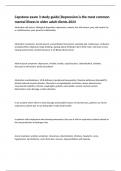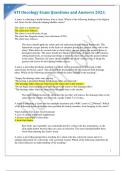Capstone exam 3 study guide|Depression is the most common
mental illness in older adult clients.2024
Alcoholism risk factors- Biological disposition, depression, anxiety, low self esteem, poor self control, hx or rebelliousness, poor parental relationships
Alcoholism symptoms- slurred speech, uncoordinated movement, unsteady gait, restlessness, confusion,
sneaking drinks, blackouts, binge drinking, arguing about drinking (I don’t drink much, only have a few), missing work/school, alcohol tolerance, 0.1% Blood Alcohol Level
Alcohol psych symptoms- depression, irritable, hostile, suspiciousness, rationalization, isolation, decrease in self esteem, denial of problem
Alcoholism manifestations- Vit B deficiency (peripheral Neuropathy), thiamine deficiency (Korsakoff’s), alcohol induced amnesic disorder, Wernicke’s encephalopathy (confusion, ataxia, abnormal eye movements) hepatitis, cirrhosis, esophagitis, gastritis, pancreatitis, anemia, immune system disfunctions, brain damage, cardiac disorders
In an accident where there is chest damage and possible fracture of ribs/sternum, patient is at risk for respiratory acidosis due to not being able to take deep breaths
In patients with emphysema who develop pneumonia, they are at risk for respiratory acidosis related to the overproduction of hydrogen ions
Acute respiratory acidosis symptoms- drowsiness, disorientation, dizziness, headache, coma, hypotension, dysrhythmias, warm flush skin, seizures, hypoventilation with hypoxia Thoracentesis- removal of fluid or air from the pleural space via transthoracic aspiration, client should be sitting up or lying in bed toward unaffected side for procedure, instruct client not to cough, breathe deeply, or move, apply pressure dressing, assess puncture site for bleeding and crepitus, monitor for signs of pneumothorax, air embolism, pulmonary edema
Assessment for dyspnea-what makes it better, what makes it worse, educate pursed lip breathing, educate conserving breath Pack year smoke- number of packs per day, multiplied by number of years smoked (20 cigs in a pack)
COPD symptoms- exertional dyspnea, wheezing and crackles, sputum production, barrel chest, prolonged expiration, orthopnea, decreased oxygen increased carbon dioxide. White blood cells should not be elevated without an infection, COPD does not cause elevation
Inhaler education- rinse mouth after use, always carry emergency inhaler for asthma on them
If a patient with asthma has a brief episode of wheezing, their inhaler has their asthma partially controlled
Patients at highest risk for aspiration pneumonia include vent, stroke, Ng tube, decreased LOC
COVID 19 precautions- nurse should wear N95 mask, gown, gloves, and face shield





